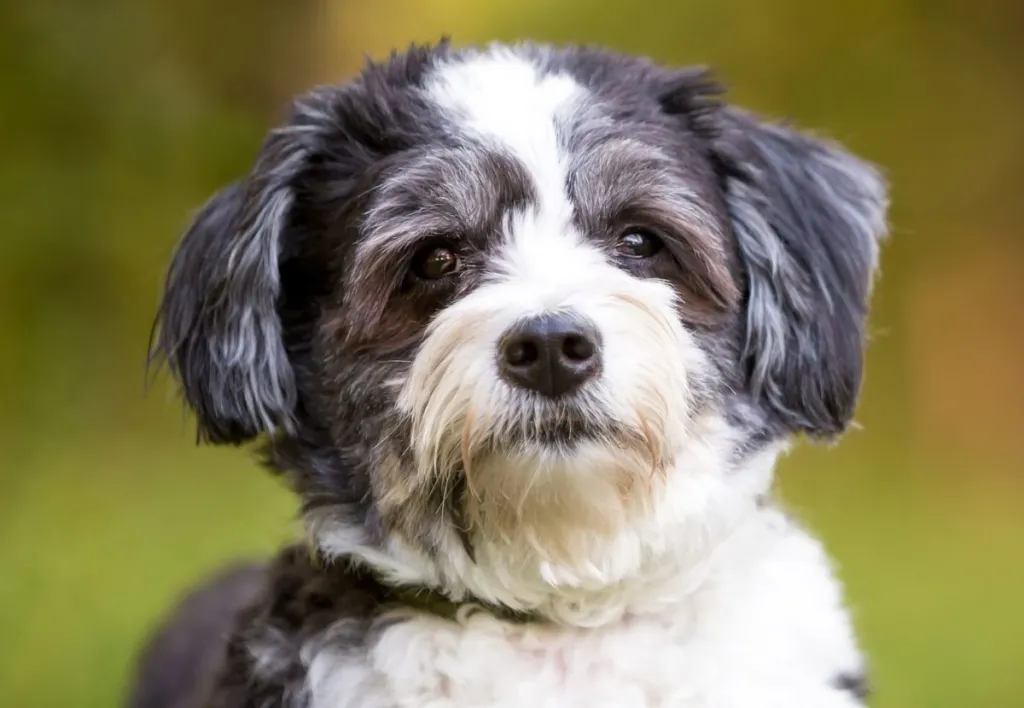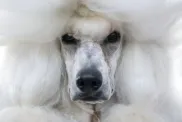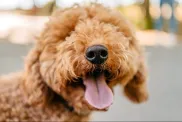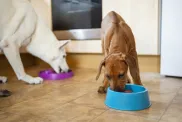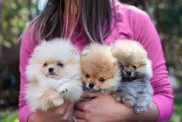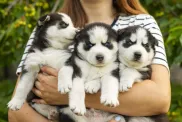The Shih-Poo is a small-to-medium-sized companion cross between the Shih Tzu and Toy Poodle dog breeds. This popular Poodle mix is known for their affectionate personality, making them a great choice for families and individuals alike. Shih-Poos typically inherit a combination of the Shih Tzu’s friendly and loyal nature with the Poodle’s intelligence and hypoallergenic coat qualities.
In terms of appearance, a full-grown Shih-Poo can vary widely, even within the same litter, as their traits may lean more towards either parent breed. Their coats are often curly or wavy and come in a variety of colors. These dogs are highly adaptable and thrive in various living environments, from apartments to houses with yards. Due to their moderate energy levels, they usually enjoy playtime as well as snuggling on the couch, making them suitable companions for individuals or families looking for a loving and low-shedding pet. Regular grooming is required to maintain their coat’s health and prevent matting.
Shih-Poo characteristics
- Height: 8 to 13 inches
- Weight: 12 to 20 pounds
- Lifespan: 12 to 15 years
Coat and color variations
The Shih-Poo, a mix between a Shih Tzu and a Poodle, comes in various coat types and colors. Their coat can range from curly, wavy, to straight, depending on the traits inherited from their parent breeds. Those with a curly coat, similar to the Poodle, have tight, dense curls that are hypoallergenic and low-shedding, though they require regular grooming to avoid matting. Shih-Poos with a wavy coat inherit a mix of the Shih Tzu’s straight and the Poodle’s curly hair, resulting in a soft texture with moderate shedding, which is easier to maintain but still benefits from consistent brushing. On the other hand, those with a straight coat resemble the Shih Tzu more closely, sporting silky, smooth hair that may shed more and need frequent grooming to keep it sleek and tidy.
The Shih-Poos coat comes in an impressive spectrum. They can be solid black, white, brown, or gray. Additionally, many Shih-Poos feature two-tone combinations like black and white, brown and white, or gray and white, often forming eye-catching patches or tuxedo-like patterns. Some dogs present a tri-color coat, blending three shades such as black, white, and brown or cream. Unique patterns like sable, where dark-tipped hairs overlay a lighter base, or brindle, with interspersed stripes of dark and light hues, add even more variety. Softer tones like cream and apricot are also common.

Physical traits and appearance
Facial features
- Shih-Poos typically have round, dark eyes that are expressive and soulful.
- Their floppy ears are covered with soft, often wavy or curly hair that hangs close to the head.
- The Shih-Poo’s nose is usually black or brown, depending on their coat color. It’s small and slightly pushed-in, a trait inherited from the Shih Tzu, giving them a cute, button-like appearance.
- Their muzzle can be short (similar to the Shih Tzu) or slightly longer (like the Poodle), giving a soft, rounded look.
Other physical attributes
- The Shih-Poo’s build is compact, sturdy, and well-proportioned without being too stocky.
- The tail may curl over their back (common in Shih Tzus) or be carried straight, often covered with soft, fluffy fur.
How big does a Shih-Poo get?
Shih-Poos are small to medium-sized dogs, and their size can vary depending on whether the Poodle parent is a Toy Poodle or a Miniature Poodle. Smaller Shih-Poos (8-12 pounds) often result from a Toy Poodle parent. Larger Shih-Poos (13-18 pounds) tend to have a Miniature Poodle parent.
Shih-Poo personality
To gain a comprehensive understanding of these traits, it’s beneficial to familiarize yourself with the Shih Tzu and Poodle parents. Shih Tzus, known for their friendliness, attentiveness, and undeniable cuteness, can exhibit a stubborn streak. However, this trait is compensated by their charming personalities. On the other hand, Poodles are characterized by intelligence, trainability, and an active nature. When it comes to Shih-Poos, their personalities typically fall somewhere in between those of their Shih Tzu and Poodle parents.
Commonly described as friendly and playful, most Shih-Poos are sized like typical lap dogs, and their moderate energy levels make them prone to extended napping sessions in your lap. Although they may not be overly eager to learn new tricks, they thrive on interaction and attention. While Shih-Poos are generally not as vocal as their Poodle parent, they may use an occasional bark to communicate displeasure, such as a missed meal. Early training and socialization are crucial, with consistency and positive reinforcement proving effective methods for fostering well-behaved Shih-Poos.
Temperament and behavior traits
- Affectionate: Loves to cuddle and form close bonds with family members.
- Playful: Enjoys interactive play, games, and short bursts of activity.
- Intelligent: Learns commands and tricks quickly with consistent training.
- Trainable: Responds well to positive reinforcement but may show occasional stubbornness.
- Social: Friendly with people, children, and other pets.
- Independent: Can entertain themselves but prefer being around their family.
- Loyal: Devoted to their owners, often following them around the house.
- Calm: Balances periods of play with relaxed, laid-back behavior.
- Adaptable: Comfortable in various living situations, from apartments to larger homes.
Training and socialization
Early socialization and positive reinforcement training are crucial due to their intelligence and potential stubbornness. Of course, their intelligence allows them to pick up commands quickly, so early training is key to establishing good behavior from the start. Use praise, treats, and affection to reward desired behavior. Shih-Poos respond well to positive reinforcement, and this approach will keep them motivated and engaged.
Training tips:
- Be Consistent: Consistency is crucial in training. Use the same commands and routines to avoid confusion. This helps your Borderdoodle understand what is expected of them.
- Keep Training Sessions Short and Fun: Shih Tzu Poodle mixes are intelligent but can lose interest if training sessions are too long or repetitive. Keep sessions short (10-15 minutes) and engage with varied activities.
- Mental Stimulation: Incorporate puzzle toys, obedience training, and interactive games into their routine to challenge their mind. A bored Shih-Poo can become restless or depressed. Once basic obedience is established, teach more advanced commands or tricks.
Shih-Poo grooming needs and care
As with all dogs, it’s important to keep up your Shih-Poo’s regular veterinary checkups to detect any health concerns early. Your vet can help you develop a care routine that will keep your dog healthy.
The Shih Tzu Poodle mix’s coat comes in an array of colors, patterns, and textures depending on their genetic makeup. Like other Poodle mixes, they don’t typically shed much. Remember that this does not mean they do not cause allergies, only that they’re less likely to do so. Of course, breeds with Poodle-type coats sometimes need additional grooming to avoid matting.
Are Shih-Poos hypoallergenic?
Shih-Poos are often described as hypoallergenic due to their low-shedding coats, which are inherited from their Poodle lineage. However, no dog is completely hypoallergenic. The hypoallergenic label means they produce fewer allergens compared to other breeds, making them a better choice for people with mild allergies. The real culprit for allergies is often proteins found in a dog’s saliva, dander, or urine, which can still be present even in low-shedding breeds.
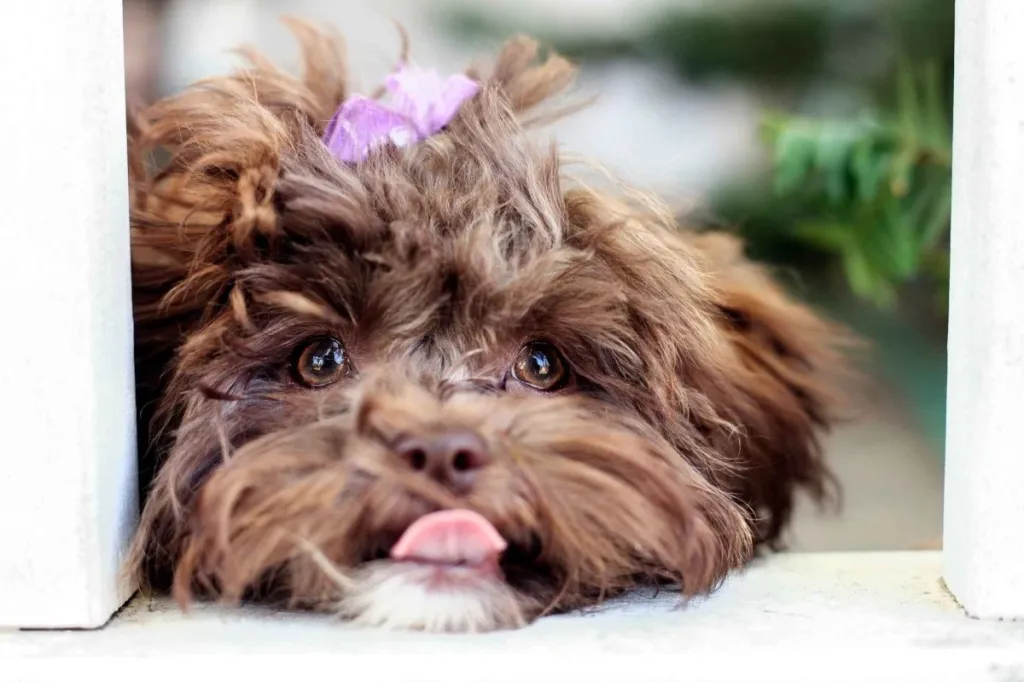
How to groom a Shih Tzu Poodle mix
Grooming a Shih-Poo involves maintaining their coat, ears, nails, and teeth. Their grooming needs can vary depending on whether they inherit more of the Poodle’s curly coat or the Shih-Tzu’s silky coat.
Coat care
Brushing:
- Frequency: Brush your Shih-Poo 2-3 times per week to prevent matting and tangles, especially if they have a curly or wavy coat. If their coat leans more toward the Poodle side, you may need to brush daily.
- Tools: Use a slicker brush or pin brush for their curly or wavy coat, and a comb to detangle any knots.
- Tip: Pay extra attention to areas that are prone to matting, like behind the ears, under the legs, and around the collar.
Bathing:
- Frequency: Bathe your Shih-Poo every 4-6 weeks or as needed. Frequent baths can dry out their skin, so stick to a gentle dog shampoo.
- Drying: After a bath, towel-dry and use a blow dryer on a low, cool setting if necessary. Make sure their coat is fully dry to prevent any moisture from causing irritation.
Trimming:
- Professional Grooming: If your Shih-Poo has a curly or thick coat like a Poodle, consider having them professionally groomed every 6-8 weeks. Groomers can shape the coat, keep it manageable, and trim around sensitive areas like the paws, face, and tail.
- Home Trimming: You can trim their coat at home using dog clippers or scissors for a tidy appearance, especially around the eyes and paws to avoid irritation.
Ear care
- Check for Dirt and Moisture: Shih-Poos may be prone to ear infections. Check their ears weekly for signs of dirt, wax buildup, or moisture, which can lead to infections.
- Cleaning: Clean their ears with a veterinary-approved ear cleaner and a cotton ball or pad. Avoid using cotton swabs, as they can push debris further into the ear.
Nail trimming
- Frequency: Trim your Shih-Poos nails every 4-6 weeks, depending on their activity level. Active dogs may naturally wear down their nails, but indoor or less active dogs will need more frequent trims.
- Tip: Use a dog nail clipper or a grinder. Be careful not to cut too far down, as hitting the quick (the blood vessel inside the nail) can be painful and cause bleeding.
Dental and eye care
- Brush Regularly: Brush your Shih-Poo’s teeth 2-3 times per week using a dog-specific toothbrush and toothpaste. Small breeds are more prone to dental problems. Frequent teeth brushing helps prevent plaque buildup.
- Dental Chews: Provide dental chews or toys to help reduce plaque and keep their teeth healthy.
- Clean Around the Eyes: If your Shih-Poo’s coat grows around their eyes, regularly trim the hair to prevent irritation. Use a clean, damp cloth to gently wipe away any eye discharge or tear stains.
Check for skin issues
- Inspect Regularly: As you groom, check their skin for any signs of irritation, redness, or bumps. If you notice anything unusual, consult a vet.
Flea, tick, and parasite control
Keep up with flea and tick prevention treatments, especially if your Shih-Poo spends much time outdoors. Regular grooming allows you to spot parasites early.
Early acclimation is key
Getting your Shih-Poo accustomed to grooming procedures from a young age makes the process easier and more enjoyable for both of you. Handle their paws frequently, examine their mouth and ears, and reward them for good behavior during grooming sessions. This positive foundation sets the stage for stress-free veterinary exams and handling throughout their lives.
Feeding and nutrition
Shih-Poos require a balanced diet tailored to their size, age, activity level, and overall health. High-quality dog food, whether commercially produced or home-prepared under veterinary guidance, is essential to meet their nutritional needs. Their diet should include the right balance of protein, fats, and carbohydrates, with added vitamins and minerals for optimal health. Since Shih-Poos are prone to obesity, portion control and avoiding excessive treats are crucial. Puppies, adults, and senior Shih-Poos each have different dietary requirements, with puppies needing more frequent meals for growth and seniors benefiting from lower-calorie diets to maintain a healthy weight.
Puppies (2-12 months)
- 4 meals per day (until about 6 months, then reduce to 3)
- Portion Size: 1/4 to 3/4 cup of puppy food per day, divided into meals.
Adults (1-7 years)
- 2 meals per day
- Portion Size by Weight: 8-12 lbs: 1/2 to 1 cup of food daily | 13-18 lbs: 3/4 to 1 1/4 cups of food daily.
Seniors (7+ years)
- 2 smaller meals per day
- Portion Size: Similar to adults, but adjust for reduced activity levels. Consider senior-specific formulas for easier digestion and joint health.
Shih-Poo and family compatibility
Shih-Poos are highly adaptable, affectionate, and social dogs, making them a wonderful choice for families of all sizes. Their playful and gentle nature allows them to get along well with children, while their small size makes them suitable for homes or apartments with limited space. Shih-Poos are also friendly with other pets, including dogs and cats. They thrive on human interaction, often following family members around and seeking companionship. Their moderate energy levels ensure they can enjoy active playtime but also appreciate calm, cuddly moments. However, they do best in families where someone is home often, as they can be prone to separation anxiety if left alone for long periods.
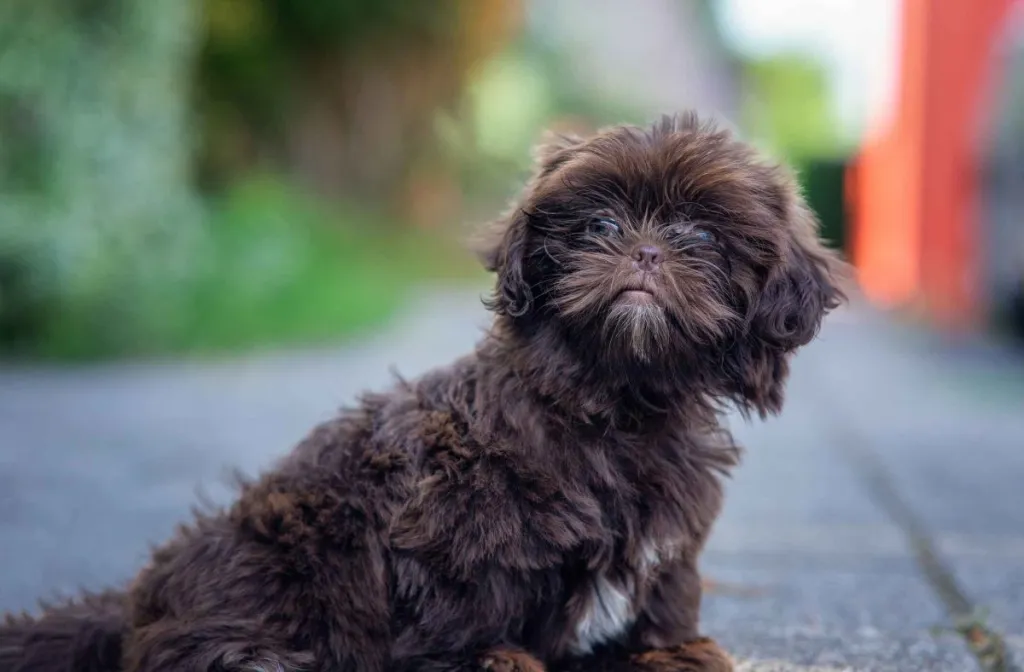
Health issues
Like any dog breed, Shih-Poos are susceptible to certain health issues that can be influenced by genetic factors from their Shih Tzu and Poodle parent breeds. Common health concerns in Shih-Poos include:
- Dental Issues: Dental problems in dogs, including Shih-Poos, involve issues such as tartar buildup, gum disease, and tooth decay. Regular dental care, including brushing, dental chews, and veterinary check-ups, is essential to prevent and address these issues.
- Ear Infections: Shih-Poos, with their floppy ears, are prone to ear infections caused by limited airflow and moisture retention. Regular cleaning and inspection of the ears, as well as keeping them dry, can help prevent infections. Veterinary attention is necessary if signs of infection, such as redness or discharge, are observed.
- Patellar Luxation (Knee Joint Problems): Patellar luxation is a condition where the kneecap (patella) dislocates from its normal position. This can lead to limping or lameness. Small breeds like Shih-Poos may be predisposed to this condition. Surgical intervention may be necessary in severe cases.
- Respiratory Issues: Brachycephalic features inherited from breeds like the Shih Tzu can contribute to respiratory issues in Shih-Poos. This includes snorting, snoring, and difficulty breathing, especially in hot or humid conditions. Care should be taken to avoid overexertion and exposure to extreme temperatures, and veterinary care may be needed if respiratory issues are pronounced.
Regular veterinary check-ups, a balanced diet, proper dental care, and regular exercise can contribute to maintaining the overall health and well-being of Shih-Poos. Additionally, responsible breeding practices that prioritize the health of the parent dogs can help mitigate the risk of hereditary health issues in Shih-Poos.
Rescue groups
If you’re looking for Shih-Poo puppies, it’s always worth starting with rescues. Despite their designer status, many may still end up in rescue organizations. Of course, it may be hard to find a breed-specific rescue for Shih-Poos because they are a mixed breed. However, you may want to try Shih Tzu or Poodle breed-specific rescues, as they often care for mixes, as well. Here are some rescues you can try:
How much are Shih-Poo puppies?
The price of Shih-Poo puppies typically ranges from $1,500 to $4,000, depending on factors such as the breeder’s reputation, location, coat color, and the puppy’s lineage. While it’s possible to find Shih-Poo puppies at significantly lower prices, these often come from less reputable sources. It’s essential to research breeders thoroughly to avoid supporting backyard breeding operations or puppy mills, which prioritize profit over the health and welfare of their dogs. Puppies from such sources may have underlying health issues or poor socialization, leading to long-term challenges. Opting for a reputable breeder can help you find a healthier pet but also avoid inadvertently contributing to inhumane breeding practices.
